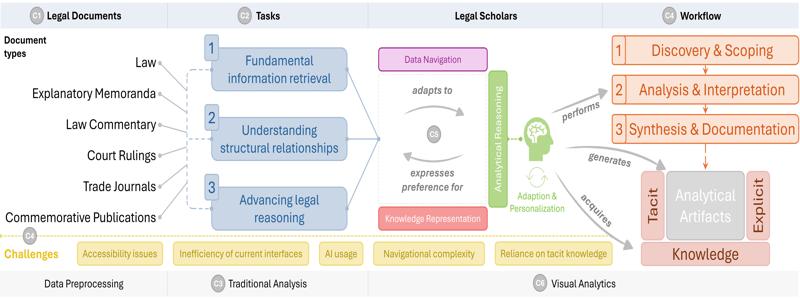
Challenges and Opportunities for Visual Analytics in Jurisprudence
D. Fürst, M. El-Assady, D. A. Keim, M. T. Fischer
arXiv Preprint, DOI:10.48550/arXiv.2412.06543, 2025Visual Analytics Law
Legal exploration, analysis, and interpretation remain complex and demanding tasks, even for experienced legal scholars, due to the domain-specific language, tacit legal concepts, and intentional ambiguities embedded in legal texts. In related, text-based domains, Visual Analytics (VA) and Large Language Models (LLMs) have become indispensable tools for navigating documents, representing knowledge, and supporting analytical reasoning. However, legal scholarship presents distinct challenges: it requires managing formal legal structure, drawing on tacit domain knowledge, and documenting intricate and accurate reasoning processes – needs that current VA systems designs and LLMs fail to address adequately. We identify previously unexamined key challenges and underexplored opportunities in applying VA to jurisprudence to explore how these technologies might better serve the legal domain. Based on semi-structured interviews with nine legal experts, we find a significant gap in tools and means that can externalize tacit legal knowledge in a form that is both explicit and machine-interpretable. Hence, we propose leveraging interactive visualization for this articulation, teaching the machine relevant semantic relationships between legal documents that inform the predictions of LLMs, facilitating the enhanced navigation betweenhierarchies of legal collections. This work introduces a user-centered VA workflow to the jurisprudential context, recognizing tacit legal knowledge and expertexperience as vital components in deriving legal insight, comparing it with established practices in other text-based domains, and outlining a research agenda thatoffers future guidance for researchers in Visual Analytics for law and beyond.
Related Publication



